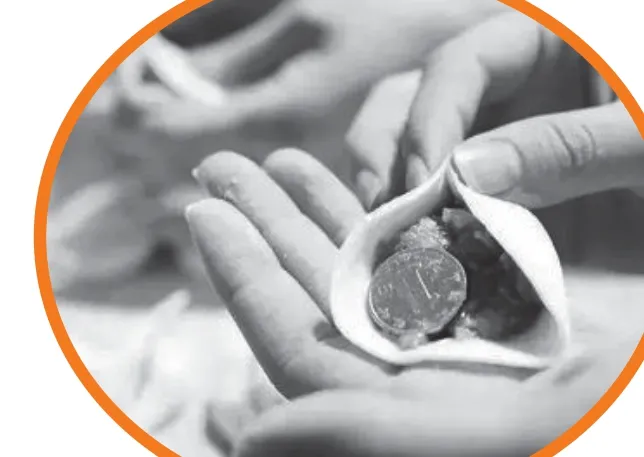世界各地的新年庆祝习俗(一)
◎熊艳婷
庆贺新年是世界各国、各地区的普遍习俗。不管是世界上哪个国家的人们,都对新的一年充满美好的希冀。“百里不同风,千里不同俗”,由于各个国家和地区的历史、文化、宗教信仰、民族习惯不同,因此也都有自己不同的庆祝新年的习俗。
China: make dumplings with coins, worship ancestors
As for the lunar calendar, the first day of the first lunar month falls on the Spring Festival which is Chinese New Year. The north and the south have different customs. At the break of1)dawn,every household in the north eats dumplings. For good luck, people often put coins,sugar, peanut2)kernels, dates and3)chestnutsinto New Year’s dumplings with meat stuffing.Those who eat coins symbolize wealth in the New Year, those who eat sugar mean they will be sweeter in the coming year, and those who eat peanut kernels symbolize health and longevity. In the south, rice is washed in the first few days, which is called“ten thousand years of grain”, which means there is a surplus of grain every year. During the Spring Festival, southerners have the custom of worshiping their ancestors and remembering the martyrs, especially in Chaoshan and southern Fujian Province. It is the peak period for worship of ancestors, and the custom of worship is4)retainedin many places.

America: write New Year’s resolutions
The New Year is a major holiday celebrated by all states in the United States. Americans also have an interesting habit of making New Year’s resolutions, which they call “New Year’s Resolutions”. This5)determinationis usually not some ambitious ambition, but some simple and6)practicalplans, such as “I will get up early”, “I will treat my neighbors well” and so on. They always speak frankly to everyone in order to be7)supervisedand encouraged.

India: cry bitterly and 8)fast
India has five days-off for the New Year from October 31 every year, and the fourth day is the New Year. On the first day of the New Year, no one is allowed to be angry with anyone, let alone lose his temper. In some parts of India, there are constant cries and tears streaming down everyone’s faces on New Year’s morning. People in some areas greet the New Year by fasting for one day and one night, starting in the early hours of the New Year and ending at midnight. Because of this custom, the Indian’s New Year is known as“crying New Year” and “fasting New Year”.

Peru: fight and punch
Peruvians greet the New Year with their fists. The city of Cusco in Peru holds a “fight match” every year. As long as they have the courage, men and women, old and young, can compete with their9)opponents. There is no deep10)hatredbetween the players, and they don’t even know each other. People fight back and forth to11)ventthe anger they have12)accumulatedduring the year and enter the New Year full of joy and hope. Although it is an occasion where punches and punches are added, festive music is played on the spot.

The Democratic People’s Republic of Korea(DPRK): stuff 13)banknotes into scarecrows, burn hair at dusk

The DPRK like China, has the custom of putting up window grilles and peach symbols on New Year’s Day. People paste couplets and pictures in every household during the New Year. At the dawn of the New Year, people stuffed some banknotes into New Year’s Eve’s pre-bound scarecrows and threw them at the crossroads to show that they would send away evil and welcome14)auspiciousstars. At dusk,people burn the hair that the whole family has lost in a year, and wish the family peace all the year round.
Germany: put fish scales in purse, climb high for good luck
Germans attach great importance to the New Year. They think that whether the New Year is good or not is directly related to the luck of the next year. They will put a few fish scales in their wallets, because fish scales and roe are New Year’s15)mascots, indicating a lot of money. Before the New Year bell rings, many Germans will climb into their chairs, and when the bell rings, they will jump down and run behind the chairs to show that they are out of trouble. There is also a custom in rural Germany—tree climbing competition. It is said that the higher the climb, the better luck it is. The tallest climber every year will be known as the “New Year’s Hero”, envied by others.

1) dawnn.黎明
2) kerneln.果仁
3) chestnutn.栗子
4) retainv.保留
5) determinationn.决心
6) practicaladj. 务实的
7) supervisev.监督
8) fastv.禁食
9) opponentn.对手
10) hatredn.仇恨
11) ventv.发泄
12) accumulatev.累积
13) banknoten.纸币
14) auspiciousadj.吉祥的
15) mascotn.吉祥物
中国:饺子里包硬币,祭拜祖先
按照农历,每年的正月初一为中国春节。春节习俗有北方和南方之分。初一破晓,在北方家家户户吃饺子,为了讨吉利,人们往往把硬币、糖、花生仁、大枣和栗子等和肉馅一起包进新年的饺子里。吃到硬币的人,象征新年发财;吃到糖的人,表示来年日子更甜美;吃到花生仁的则象征健康长寿。在南方,人们在头几天淘米,称作“万年粮米”,意思是年年有余粮。南方人在过年的时候有祭拜祖先、缅怀先烈这一习俗,特别是在潮汕和闽南一带。过年的时候是祭拜祖先的高峰期,很多地方都保留着祭拜的习俗。
美国:写新年决心
新年是全美各州共同庆祝的主要节日。美国人还有一个有意思的习惯,那就是在新年许愿立志,称之为“新年决心”。这决心通常不是什么宏图大志,而是一些朴实而实际的打算,如“我一定要早起”“我要好好对待邻居”等。他们总是坦率地讲给大家听,以期得到监督和鼓励。
印度:痛哭不食
在印度,每年10 月31 日起为新年假期,共5 天,第四天为新年。新年第一天,谁也不许对人生气,更不准发脾气。印度有些地区,新年的早上,家家户户哭声不断,人人脸上涕泪横流。有些地区的人们会禁食一天一夜来迎接新的一年,由新年凌晨开始,午夜结束。由于这种习俗,印度的新年被称为“痛哭新年”“禁食新年”。
秘鲁:大打出手,拳脚相加
秘鲁人用拳头迎接新年。秘鲁的库斯科市每年都会举行“打架比赛”。只要有胆量,无论男女老少,都可以上场和对手比拼一番。选手之间并没有深仇大恨,甚至彼此都不认识,人们打来打去就是为了将一年来积攒的怒气发泄出来,怀着充满欢乐和希望的心情步入新的一年。虽然是拳脚相加的场合,但现场播放的却是喜庆的音乐。
朝鲜:稻草人中塞纸币,黄昏时分烧头发
朝鲜和中国一样,新年也有贴窗花、桃符的习俗。新年时,朝鲜人家家户户贴对联和年画。黎明时分,人们把一些纸币塞进除夕预先扎好的稻草人中,扔到十字路口,表示送走邪恶,迎接吉祥福星。黄昏,人们又将全家人一年中脱落的头发烧掉,祝愿家人四季平安。
德国:钱包放鱼鳞,爬高祈好运
德国人对新年非常重视,他们认为新年过得好不好直接关系到下一年的运气。他们会在钱包里放几片鱼鳞,因为鱼鳞和鱼子都是新年吉祥物,预示着财源滚滚。新年钟声响起前,很多德国人会爬到椅子上,待钟声传来,就跳下来跑到椅子背后,以示甩去灾祸。在德国农村还流传着一种风俗——爬树比赛,据说爬得越高运气就越好。每年爬得最高的人会被誉为“新年英雄”,被其他人羡慕。
- 疯狂英语·初中天地的其它文章
- 元 日
- 众志成城
- 一鸣惊人
- 世界各地的新年庆祝习俗(二)
- 趣味英语听力
- 口语步步高兔年话“兔”

